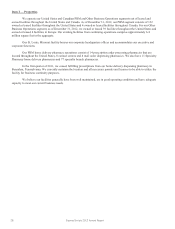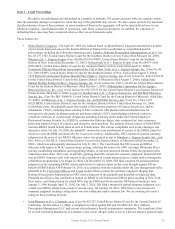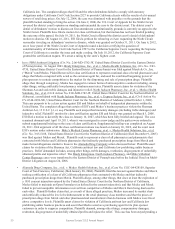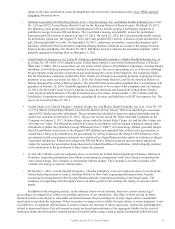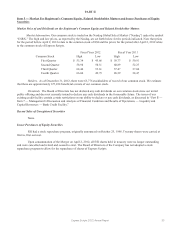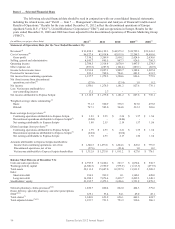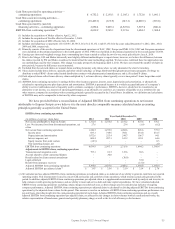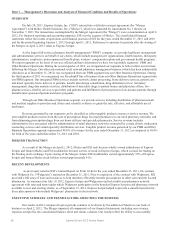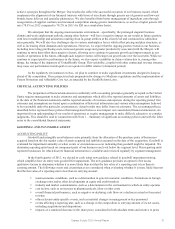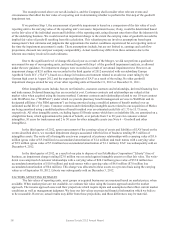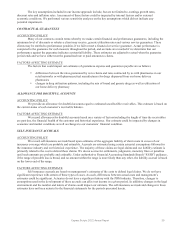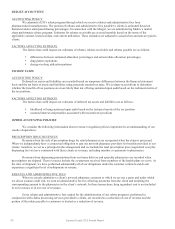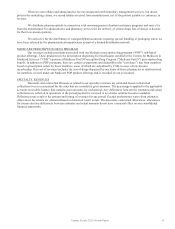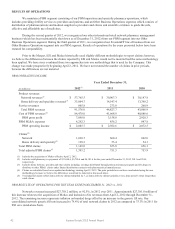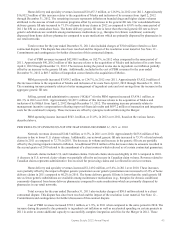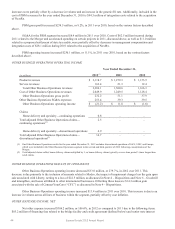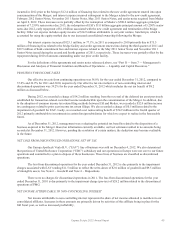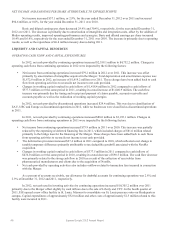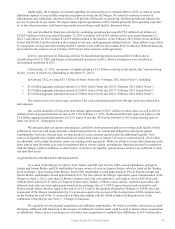Express Scripts 2012 Annual Report Download - page 39
Download and view the complete annual report
Please find page 39 of the 2012 Express Scripts annual report below. You can navigate through the pages in the report by either clicking on the pages listed below, or by using the keyword search tool below to find specific information within the annual report.
Express Scripts 2012 Annual Report 37
achieve synergies throughout the Merger. Our results also reflect the successful execution of our business model, which
emphasizes the alignment of our financial interests with those of our clients through greater use of generics and low-cost
brands, home delivery and specialty pharmacies. We also benefited from better management of ingredient costs through
renegotiation of supplier contracts and increased competition among generic manufacturers, as well as a higher generic fill
rate (78.5% in 2012 compared to 74.2% in 2011 for ESI on a stand-alone basis).
We anticipate that the ongoing macroeconomic environment—specifically, the prolonged stagnant business
climate and weak employment outlook, among other factors—will have a negative impact on our results in future quarters,
with lower membership and utilization resulting from in-group attrition at the client level and continued low utilization
rates generally. We will also face challenges due to various marketplace forces which affect pricing and plan structures, as
well as increasing client demands and expectations. However, we expect that the ongoing positive trends in our business,
including lower drug purchasing costs, increased generic usage and greater productivity associated with the Merger, will
continue to more than offset these negative factors, allowing us to continue to generate growth and improvements in our
results of operations in the future, although such negative factors will temper our growth rate over the near term. While we
continue to expect positive performance in the future, we also expect variability in claims volume due to, among other
things, the timing of the departure of UnitedHealth Group. This variability, coupled with other contractual revenue streams,
may cause our performance trends quarter over quarter to differ relative to historical periods.
As the regulatory environment evolves, we plan to continue to make significant investments designed to keep us
ahead of the competition. These projects include preparation for changes to Medicare regulations and the implementation of
Patient Protection and Affordable Care Act, as amended by the Health Reform Laws.
CRITICAL ACCOUNTING POLICIES
The preparation of financial statements in conformity with accounting principles generally accepted in the United
States requires management to make estimates and assumptions which affect the reported amounts of assets and liabilities
at the date of the financial statements and the reported amounts of revenues and expenses during the reporting period. Our
estimates and assumptions are based upon a combination of historical information and various other assumptions believed
to be reasonable under the particular circumstances. Actual results may differ from our estimates. The accounting policies
described below represent those policies that management believes most impact our consolidated financial statements, are
important for an understanding of our results of operations or require management to make difficult, subjective or complex
judgments. This should be read in conjunction with Note 1 – Summary of significant accounting policies and with the other
notes to the consolidated financial statements.
GOODWILL AND INTANGIBLE ASSETS
ACCOUNTING POLICY
Goodwill and intangible asset balances arise primarily from the allocation of the purchase price of businesses
acquired based on the fair market value of assets acquired and liabilities assumed on the date of the acquisition. Goodwill is
evaluated for impairment annually or when events or circumstances occur indicating that goodwill might be impaired. We
determine reporting units based on component parts of our business one level below the segment level. Our reporting units
represent businesses for which discrete financial information is available and reviewed regularly by segment management.
In the fourth quarter of 2011, we elected to early adopt new guidance related to goodwill impairment testing,
which simplifies how an entity tests goodwill for impairment. The new guidance provides an option to first assess
qualitative factors to determine whether it is more likely than not that the fair value of a reporting unit is less than its
carrying amount. The following events and circumstances are considered when evaluating whether it is more likely than not
that the fair value of a reporting unit is less than its carrying amount:
macroeconomic conditions, such as a deterioration in general economic conditions, fluctuations in foreign
exchange rates and/or other developments in equity and credit markets
industry and market considerations, such as a deterioration in the environment in which an entity operates
cost factors, such as an increase in pharmaceuticals, labor or other costs
overall financial performance, such as negative or declining cash flows or a decline in actual or forecasted
revenue
other relevant entity-specific events, such as material changes in management or key personnel
events affecting a reporting unit, such as a change in the composition or carrying amount of its net assets,
including acquisitions and dispositions
impacts of a sustained decrease in the share price, considered in both absolute terms and relative to peers



